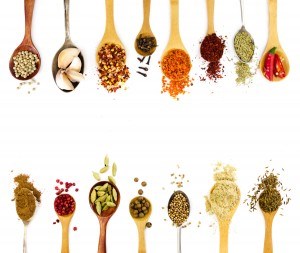One of the most useful skills to have as a beginner chef is to know how to use herbs and spices to compliment the flavor of your food. In today’s supermarkets most food comes pre-seasoned. Unfortunately that often means going overboard on salt or overpowering the natural flavors of the food. One way to avoid this is to buy fresh food and spice it up yourself.Knowing which herbs and spices and how much to use can be difficult. But this beginner’s guide will tell you everything you need to know about how to include various herbs and spices into your meals.
Why spice it yourself?
If you can buy a frozen stir-fry–spices included–at the grocery store why even bother learning how to use herbs and spices properly? As mentioned earlier, those pre-seasoned foods probably amount to added salt and sugar into your meals. This will tantalize your tastebuds, but it’s also not so great for you health-wise. Seasoning yourself allows you to take control of the food you consume.Using your own herbs and spices will also help you discover new flavor combinations, allowing you to make more meals with fewer items. If you take advantage of buying certain items in bulk–like rice and beans–you will be amazed at how many meals you can pull off with just a few variations in the spices you use.Oftentimes people will buy pre-made “spice packets” at the grocery store for making various meals (Swedish meatballs, sloppy joes, taco seasoning, etc). While these are handy, if you take a look at the ingredients on the back you might find you already have most of these herbs and spices in your cabinet, minus all of the un-pronounceable additives.
Herbs, spices, and their uses
Basil. Basil is a staple for many sauces. Pair it with meals that include tomatoes and soft, mild cheeses (mozzarella, for example). Fresh basil leaves are miles above the dried ones in terms of taste and texture. Fresh basil is a must for pizza, pesto, and pasta and you’ll want to use a good amount. Buying fresh basil can be expensive, but growing it yourself is not. A well-maintained basil plant on a sunny windowsill will provide plenty of leaves.Pairings: parsley, oregano, garlic, lemongrassCayenne pepper. If you like your spices spicy, cayenne pepper will be your new best friend. No need to douse all of your food in hot sauce to get your fix of spicy foods. Adding hot pepper powder is a great way to compliment certain dishes. Add cayenne to chicken, beef, or fish and also vegetable medleys like zucchini, corn, and bell peppers.Pairings: lemon zest, paprika, cinnamon, cuminGinger. Many people avoid ginger unless it’s in candy or herbal tea to help them get over a cold. You might not even notice, for example, that ginger is in many of your favorite Asian dishes. Ginger also works with dishes involving beef, chicken and fish, and pairs well with sweet potato, carrots, and nuts.Pairings: garlic, mint, chilli Garlic. Just like with basil, having fresh garlic on hand always pays off. Fortunately, garlic has quite a long shelf life. It’s more difficult to find a dish that wouldn’t be improved by adding garlic, but it works especially well in tomato sauces, beef, beans, chicken, and potatoes.Pairings: basil, parsley, ginger, oregano, dill, turmeric

